Ebola Viral Disease: A Comprehensive Review of the Etiology and Spread
VerifiedAdded on 2020/03/16
|17
|4908
|36
Report
AI Summary
This report provides a comprehensive review of Ebola Viral Disease (EVD), examining its etiology, epidemiology, and management. The report delves into the transmission of the virus, highlighting the role of direct contact with infected body fluids and contaminated objects. It discusses the incubation period, symptoms such as fever, diarrhea, and vomiting, and the potential for severe complications like hemorrhagic fever. The epidemiology section traces the history of EVD outbreaks, including the 1976 outbreak and the more recent epidemic in West Africa, emphasizing the high fatality rates associated with different strains. The report also explores the agents of EVD, focusing on the Ebolavirus genus and its various species, and the structure of Filoviridae. It investigates the reservoir of the virus, with bats being identified as a potential source, and examines environmental factors that contribute to the spread of the disease, such as poor sanitation and poverty. The report also discusses the diagnostic methods used for EVD, including serological tests and PCR assays, and the challenges associated with these methods. Finally, it highlights the current treatment and prevention strategies, emphasizing the ongoing research and development efforts to combat the disease.
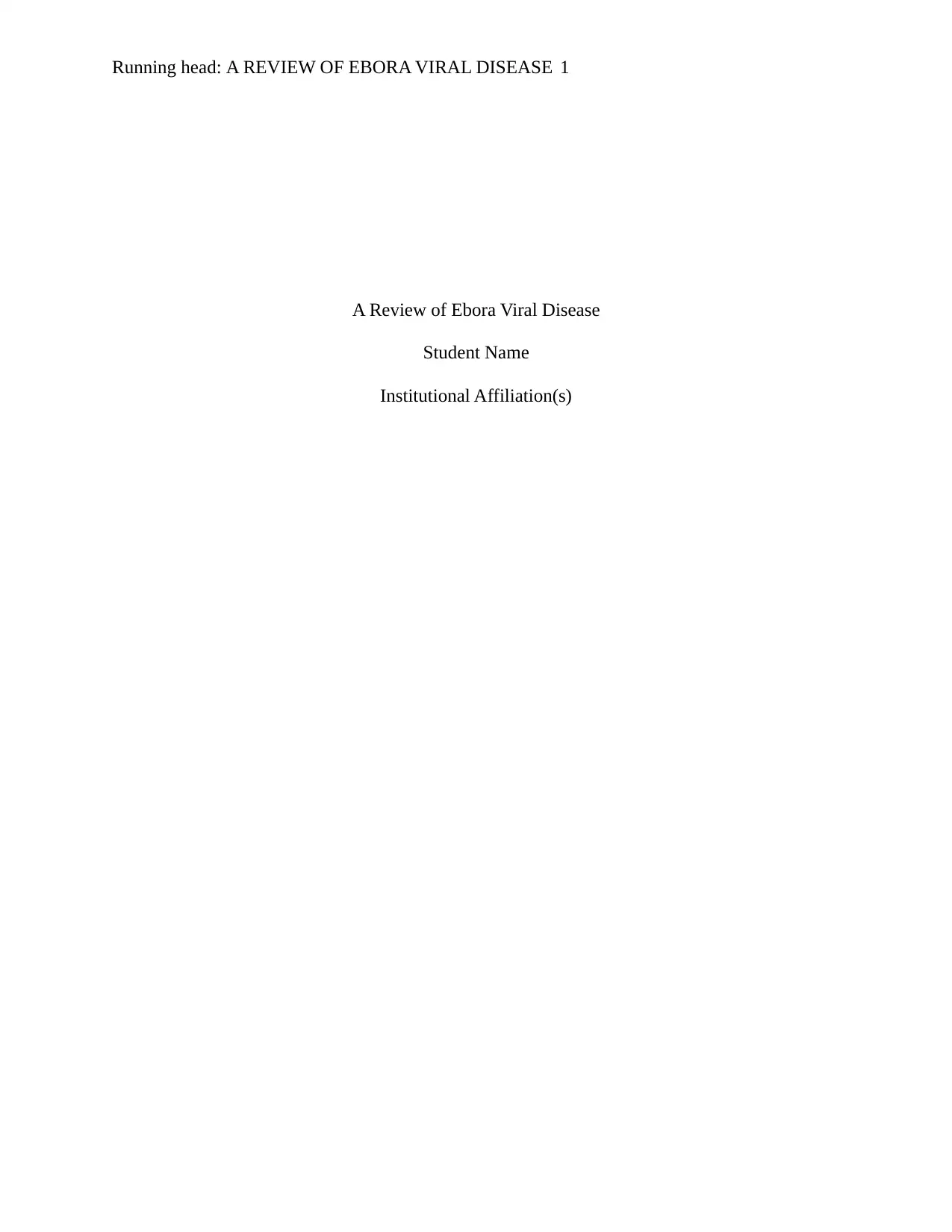
Running head: A REVIEW OF EBORA VIRAL DISEASE 1
A Review of Ebora Viral Disease
Student Name
Institutional Affiliation(s)
A Review of Ebora Viral Disease
Student Name
Institutional Affiliation(s)
Paraphrase This Document
Need a fresh take? Get an instant paraphrase of this document with our AI Paraphraser
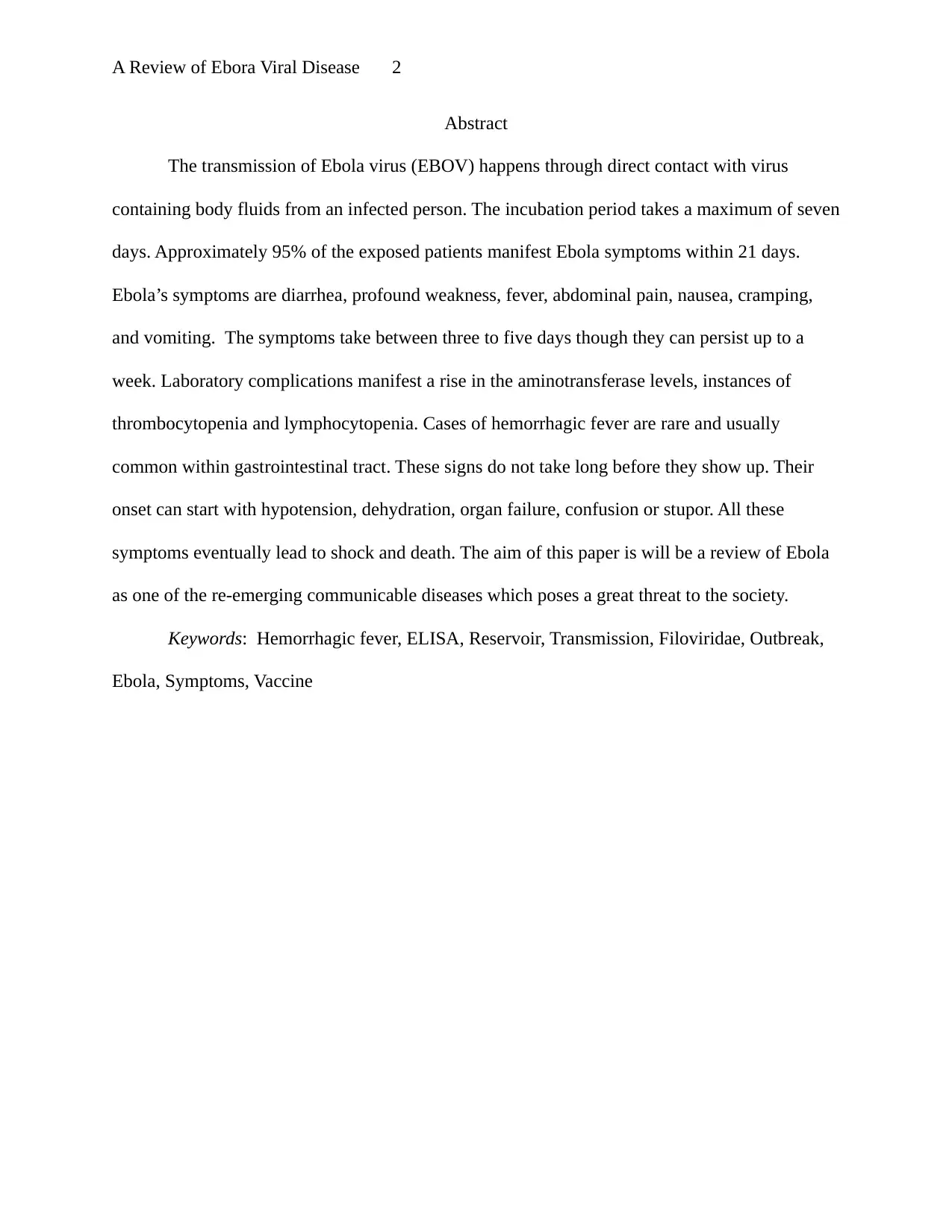
A Review of Ebora Viral Disease 2
Abstract
The transmission of Ebola virus (EBOV) happens through direct contact with virus
containing body fluids from an infected person. The incubation period takes a maximum of seven
days. Approximately 95% of the exposed patients manifest Ebola symptoms within 21 days.
Ebola’s symptoms are diarrhea, profound weakness, fever, abdominal pain, nausea, cramping,
and vomiting. The symptoms take between three to five days though they can persist up to a
week. Laboratory complications manifest a rise in the aminotransferase levels, instances of
thrombocytopenia and lymphocytopenia. Cases of hemorrhagic fever are rare and usually
common within gastrointestinal tract. These signs do not take long before they show up. Their
onset can start with hypotension, dehydration, organ failure, confusion or stupor. All these
symptoms eventually lead to shock and death. The aim of this paper is will be a review of Ebola
as one of the re-emerging communicable diseases which poses a great threat to the society.
Keywords: Hemorrhagic fever, ELISA, Reservoir, Transmission, Filoviridae, Outbreak,
Ebola, Symptoms, Vaccine
Abstract
The transmission of Ebola virus (EBOV) happens through direct contact with virus
containing body fluids from an infected person. The incubation period takes a maximum of seven
days. Approximately 95% of the exposed patients manifest Ebola symptoms within 21 days.
Ebola’s symptoms are diarrhea, profound weakness, fever, abdominal pain, nausea, cramping,
and vomiting. The symptoms take between three to five days though they can persist up to a
week. Laboratory complications manifest a rise in the aminotransferase levels, instances of
thrombocytopenia and lymphocytopenia. Cases of hemorrhagic fever are rare and usually
common within gastrointestinal tract. These signs do not take long before they show up. Their
onset can start with hypotension, dehydration, organ failure, confusion or stupor. All these
symptoms eventually lead to shock and death. The aim of this paper is will be a review of Ebola
as one of the re-emerging communicable diseases which poses a great threat to the society.
Keywords: Hemorrhagic fever, ELISA, Reservoir, Transmission, Filoviridae, Outbreak,
Ebola, Symptoms, Vaccine
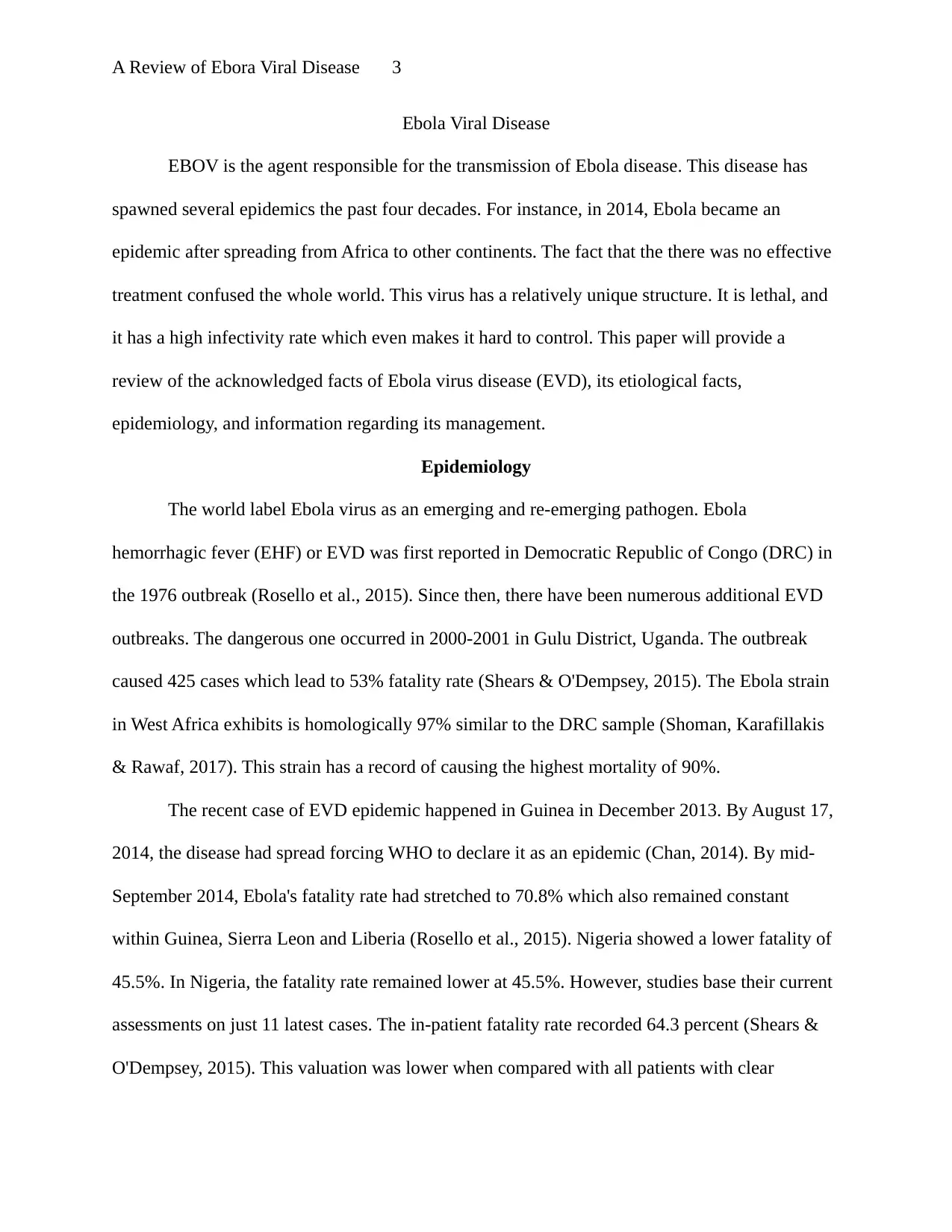
A Review of Ebora Viral Disease 3
Ebola Viral Disease
EBOV is the agent responsible for the transmission of Ebola disease. This disease has
spawned several epidemics the past four decades. For instance, in 2014, Ebola became an
epidemic after spreading from Africa to other continents. The fact that the there was no effective
treatment confused the whole world. This virus has a relatively unique structure. It is lethal, and
it has a high infectivity rate which even makes it hard to control. This paper will provide a
review of the acknowledged facts of Ebola virus disease (EVD), its etiological facts,
epidemiology, and information regarding its management.
Epidemiology
The world label Ebola virus as an emerging and re-emerging pathogen. Ebola
hemorrhagic fever (EHF) or EVD was first reported in Democratic Republic of Congo (DRC) in
the 1976 outbreak (Rosello et al., 2015). Since then, there have been numerous additional EVD
outbreaks. The dangerous one occurred in 2000-2001 in Gulu District, Uganda. The outbreak
caused 425 cases which lead to 53% fatality rate (Shears & O'Dempsey, 2015). The Ebola strain
in West Africa exhibits is homologically 97% similar to the DRC sample (Shoman, Karafillakis
& Rawaf, 2017). This strain has a record of causing the highest mortality of 90%.
The recent case of EVD epidemic happened in Guinea in December 2013. By August 17,
2014, the disease had spread forcing WHO to declare it as an epidemic (Chan, 2014). By mid-
September 2014, Ebola's fatality rate had stretched to 70.8% which also remained constant
within Guinea, Sierra Leon and Liberia (Rosello et al., 2015). Nigeria showed a lower fatality of
45.5%. In Nigeria, the fatality rate remained lower at 45.5%. However, studies base their current
assessments on just 11 latest cases. The in-patient fatality rate recorded 64.3 percent (Shears &
O'Dempsey, 2015). This valuation was lower when compared with all patients with clear
Ebola Viral Disease
EBOV is the agent responsible for the transmission of Ebola disease. This disease has
spawned several epidemics the past four decades. For instance, in 2014, Ebola became an
epidemic after spreading from Africa to other continents. The fact that the there was no effective
treatment confused the whole world. This virus has a relatively unique structure. It is lethal, and
it has a high infectivity rate which even makes it hard to control. This paper will provide a
review of the acknowledged facts of Ebola virus disease (EVD), its etiological facts,
epidemiology, and information regarding its management.
Epidemiology
The world label Ebola virus as an emerging and re-emerging pathogen. Ebola
hemorrhagic fever (EHF) or EVD was first reported in Democratic Republic of Congo (DRC) in
the 1976 outbreak (Rosello et al., 2015). Since then, there have been numerous additional EVD
outbreaks. The dangerous one occurred in 2000-2001 in Gulu District, Uganda. The outbreak
caused 425 cases which lead to 53% fatality rate (Shears & O'Dempsey, 2015). The Ebola strain
in West Africa exhibits is homologically 97% similar to the DRC sample (Shoman, Karafillakis
& Rawaf, 2017). This strain has a record of causing the highest mortality of 90%.
The recent case of EVD epidemic happened in Guinea in December 2013. By August 17,
2014, the disease had spread forcing WHO to declare it as an epidemic (Chan, 2014). By mid-
September 2014, Ebola's fatality rate had stretched to 70.8% which also remained constant
within Guinea, Sierra Leon and Liberia (Rosello et al., 2015). Nigeria showed a lower fatality of
45.5%. In Nigeria, the fatality rate remained lower at 45.5%. However, studies base their current
assessments on just 11 latest cases. The in-patient fatality rate recorded 64.3 percent (Shears &
O'Dempsey, 2015). This valuation was lower when compared with all patients with clear
⊘ This is a preview!⊘
Do you want full access?
Subscribe today to unlock all pages.

Trusted by 1+ million students worldwide
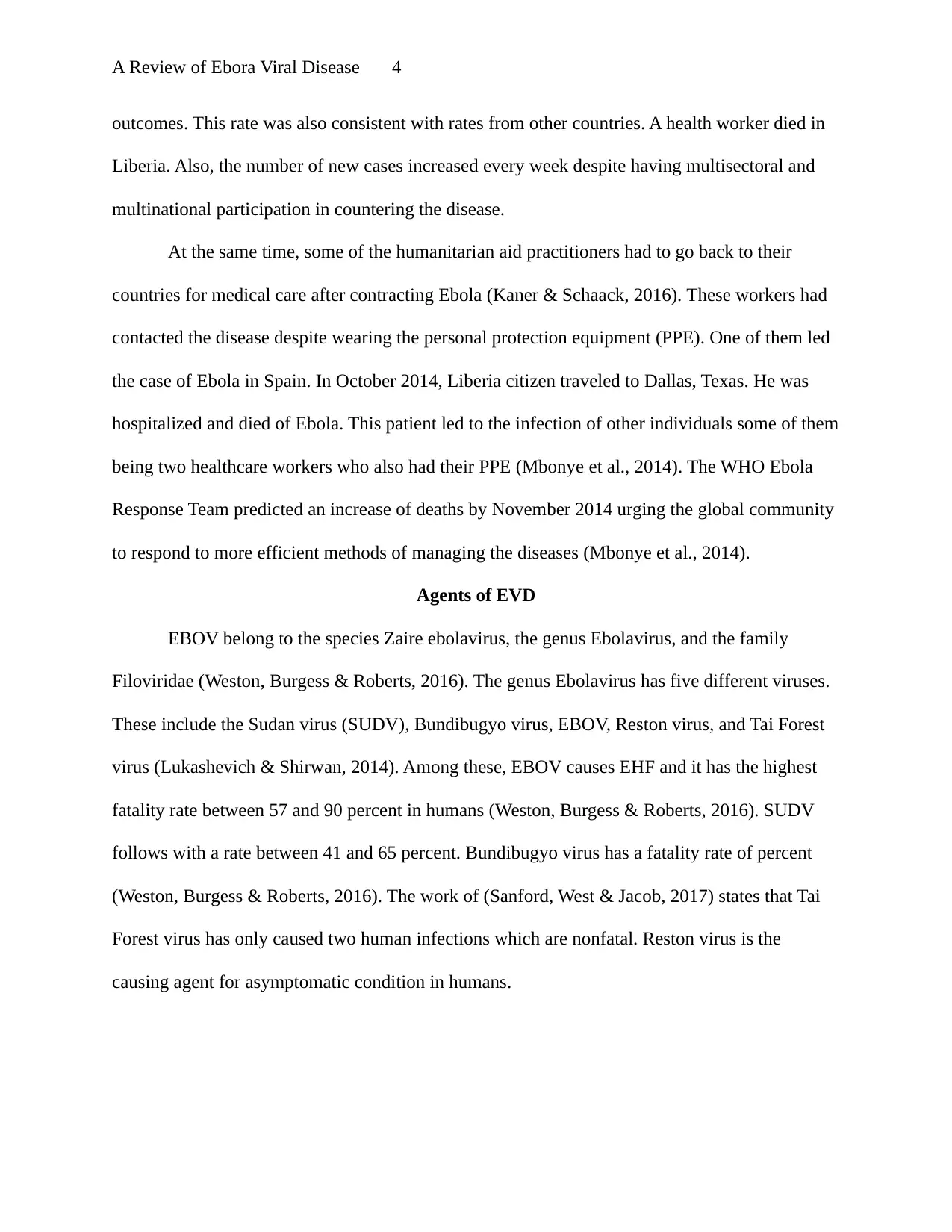
A Review of Ebora Viral Disease 4
outcomes. This rate was also consistent with rates from other countries. A health worker died in
Liberia. Also, the number of new cases increased every week despite having multisectoral and
multinational participation in countering the disease.
At the same time, some of the humanitarian aid practitioners had to go back to their
countries for medical care after contracting Ebola (Kaner & Schaack, 2016). These workers had
contacted the disease despite wearing the personal protection equipment (PPE). One of them led
the case of Ebola in Spain. In October 2014, Liberia citizen traveled to Dallas, Texas. He was
hospitalized and died of Ebola. This patient led to the infection of other individuals some of them
being two healthcare workers who also had their PPE (Mbonye et al., 2014). The WHO Ebola
Response Team predicted an increase of deaths by November 2014 urging the global community
to respond to more efficient methods of managing the diseases (Mbonye et al., 2014).
Agents of EVD
EBOV belong to the species Zaire ebolavirus, the genus Ebolavirus, and the family
Filoviridae (Weston, Burgess & Roberts, 2016). The genus Ebolavirus has five different viruses.
These include the Sudan virus (SUDV), Bundibugyo virus, EBOV, Reston virus, and Tai Forest
virus (Lukashevich & Shirwan, 2014). Among these, EBOV causes EHF and it has the highest
fatality rate between 57 and 90 percent in humans (Weston, Burgess & Roberts, 2016). SUDV
follows with a rate between 41 and 65 percent. Bundibugyo virus has a fatality rate of percent
(Weston, Burgess & Roberts, 2016). The work of (Sanford, West & Jacob, 2017) states that Tai
Forest virus has only caused two human infections which are nonfatal. Reston virus is the
causing agent for asymptomatic condition in humans.
outcomes. This rate was also consistent with rates from other countries. A health worker died in
Liberia. Also, the number of new cases increased every week despite having multisectoral and
multinational participation in countering the disease.
At the same time, some of the humanitarian aid practitioners had to go back to their
countries for medical care after contracting Ebola (Kaner & Schaack, 2016). These workers had
contacted the disease despite wearing the personal protection equipment (PPE). One of them led
the case of Ebola in Spain. In October 2014, Liberia citizen traveled to Dallas, Texas. He was
hospitalized and died of Ebola. This patient led to the infection of other individuals some of them
being two healthcare workers who also had their PPE (Mbonye et al., 2014). The WHO Ebola
Response Team predicted an increase of deaths by November 2014 urging the global community
to respond to more efficient methods of managing the diseases (Mbonye et al., 2014).
Agents of EVD
EBOV belong to the species Zaire ebolavirus, the genus Ebolavirus, and the family
Filoviridae (Weston, Burgess & Roberts, 2016). The genus Ebolavirus has five different viruses.
These include the Sudan virus (SUDV), Bundibugyo virus, EBOV, Reston virus, and Tai Forest
virus (Lukashevich & Shirwan, 2014). Among these, EBOV causes EHF and it has the highest
fatality rate between 57 and 90 percent in humans (Weston, Burgess & Roberts, 2016). SUDV
follows with a rate between 41 and 65 percent. Bundibugyo virus has a fatality rate of percent
(Weston, Burgess & Roberts, 2016). The work of (Sanford, West & Jacob, 2017) states that Tai
Forest virus has only caused two human infections which are nonfatal. Reston virus is the
causing agent for asymptomatic condition in humans.
Paraphrase This Document
Need a fresh take? Get an instant paraphrase of this document with our AI Paraphraser
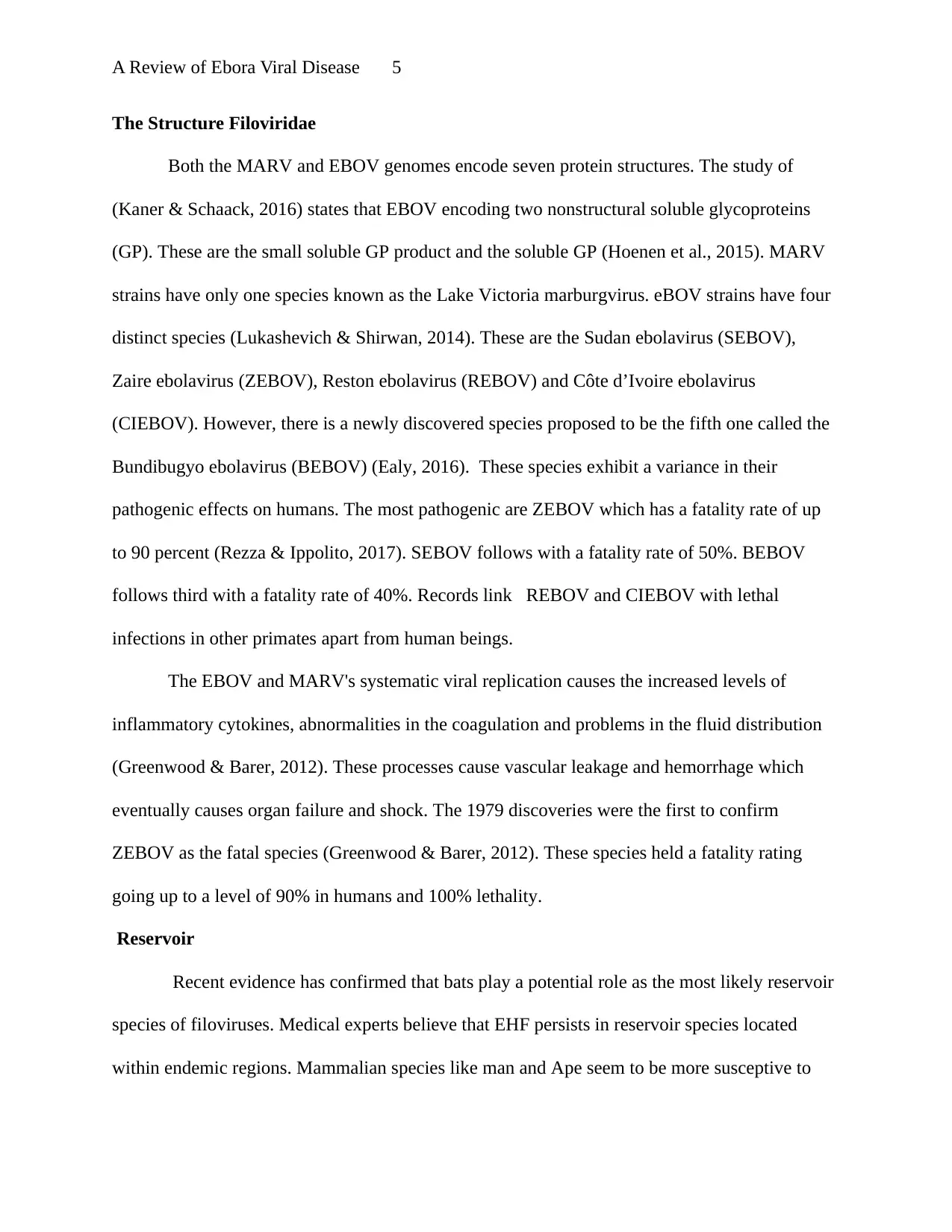
A Review of Ebora Viral Disease 5
The Structure Filoviridae
Both the MARV and EBOV genomes encode seven protein structures. The study of
(Kaner & Schaack, 2016) states that EBOV encoding two nonstructural soluble glycoproteins
(GP). These are the small soluble GP product and the soluble GP (Hoenen et al., 2015). MARV
strains have only one species known as the Lake Victoria marburgvirus. eBOV strains have four
distinct species (Lukashevich & Shirwan, 2014). These are the Sudan ebolavirus (SEBOV),
Zaire ebolavirus (ZEBOV), Reston ebolavirus (REBOV) and Côte d’Ivoire ebolavirus
(CIEBOV). However, there is a newly discovered species proposed to be the fifth one called the
Bundibugyo ebolavirus (BEBOV) (Ealy, 2016). These species exhibit a variance in their
pathogenic effects on humans. The most pathogenic are ZEBOV which has a fatality rate of up
to 90 percent (Rezza & Ippolito, 2017). SEBOV follows with a fatality rate of 50%. BEBOV
follows third with a fatality rate of 40%. Records link REBOV and CIEBOV with lethal
infections in other primates apart from human beings.
The EBOV and MARV's systematic viral replication causes the increased levels of
inflammatory cytokines, abnormalities in the coagulation and problems in the fluid distribution
(Greenwood & Barer, 2012). These processes cause vascular leakage and hemorrhage which
eventually causes organ failure and shock. The 1979 discoveries were the first to confirm
ZEBOV as the fatal species (Greenwood & Barer, 2012). These species held a fatality rating
going up to a level of 90% in humans and 100% lethality.
Reservoir
Recent evidence has confirmed that bats play a potential role as the most likely reservoir
species of filoviruses. Medical experts believe that EHF persists in reservoir species located
within endemic regions. Mammalian species like man and Ape seem to be more susceptive to
The Structure Filoviridae
Both the MARV and EBOV genomes encode seven protein structures. The study of
(Kaner & Schaack, 2016) states that EBOV encoding two nonstructural soluble glycoproteins
(GP). These are the small soluble GP product and the soluble GP (Hoenen et al., 2015). MARV
strains have only one species known as the Lake Victoria marburgvirus. eBOV strains have four
distinct species (Lukashevich & Shirwan, 2014). These are the Sudan ebolavirus (SEBOV),
Zaire ebolavirus (ZEBOV), Reston ebolavirus (REBOV) and Côte d’Ivoire ebolavirus
(CIEBOV). However, there is a newly discovered species proposed to be the fifth one called the
Bundibugyo ebolavirus (BEBOV) (Ealy, 2016). These species exhibit a variance in their
pathogenic effects on humans. The most pathogenic are ZEBOV which has a fatality rate of up
to 90 percent (Rezza & Ippolito, 2017). SEBOV follows with a fatality rate of 50%. BEBOV
follows third with a fatality rate of 40%. Records link REBOV and CIEBOV with lethal
infections in other primates apart from human beings.
The EBOV and MARV's systematic viral replication causes the increased levels of
inflammatory cytokines, abnormalities in the coagulation and problems in the fluid distribution
(Greenwood & Barer, 2012). These processes cause vascular leakage and hemorrhage which
eventually causes organ failure and shock. The 1979 discoveries were the first to confirm
ZEBOV as the fatal species (Greenwood & Barer, 2012). These species held a fatality rating
going up to a level of 90% in humans and 100% lethality.
Reservoir
Recent evidence has confirmed that bats play a potential role as the most likely reservoir
species of filoviruses. Medical experts believe that EHF persists in reservoir species located
within endemic regions. Mammalian species like man and Ape seem to be more susceptive to
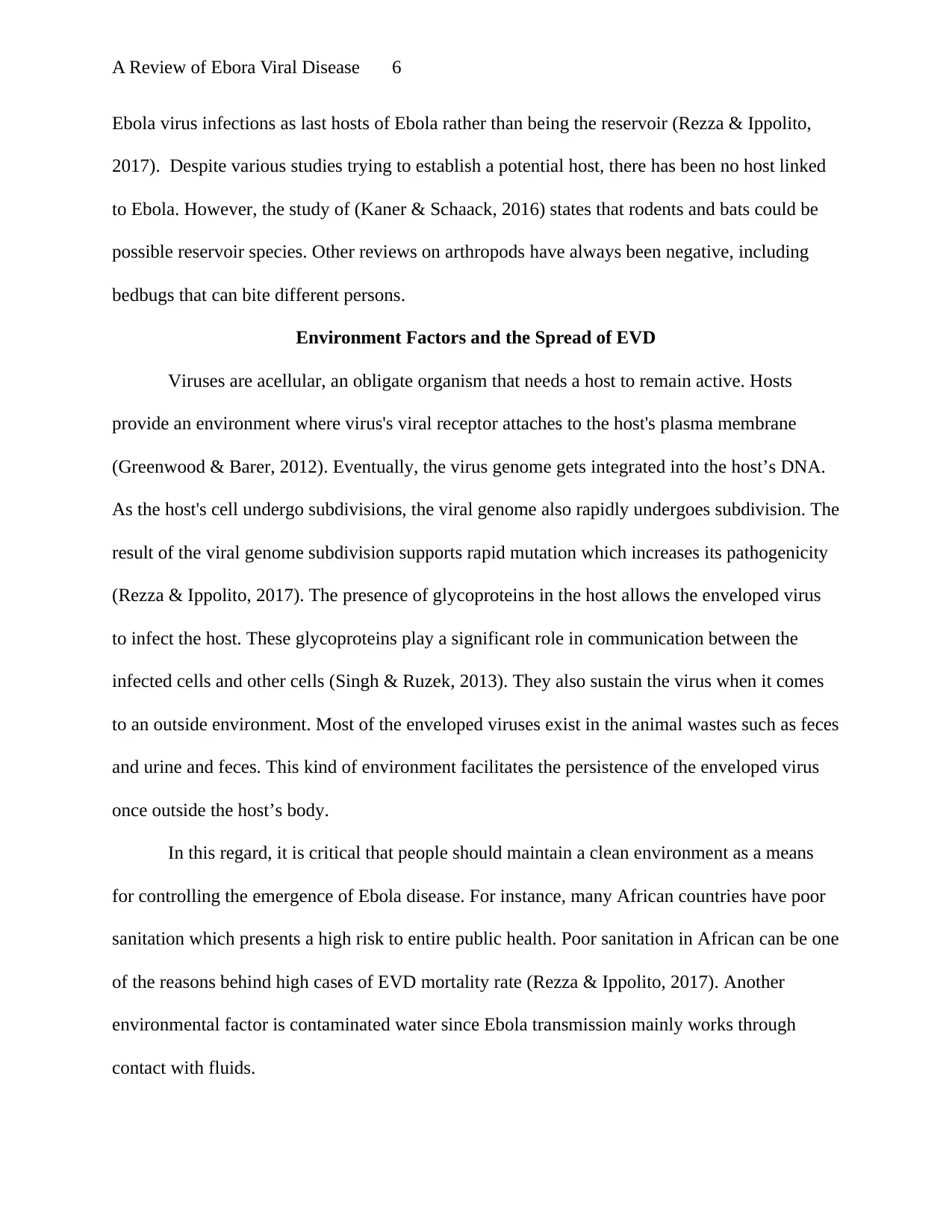
A Review of Ebora Viral Disease 6
Ebola virus infections as last hosts of Ebola rather than being the reservoir (Rezza & Ippolito,
2017). Despite various studies trying to establish a potential host, there has been no host linked
to Ebola. However, the study of (Kaner & Schaack, 2016) states that rodents and bats could be
possible reservoir species. Other reviews on arthropods have always been negative, including
bedbugs that can bite different persons.
Environment Factors and the Spread of EVD
Viruses are acellular, an obligate organism that needs a host to remain active. Hosts
provide an environment where virus's viral receptor attaches to the host's plasma membrane
(Greenwood & Barer, 2012). Eventually, the virus genome gets integrated into the host’s DNA.
As the host's cell undergo subdivisions, the viral genome also rapidly undergoes subdivision. The
result of the viral genome subdivision supports rapid mutation which increases its pathogenicity
(Rezza & Ippolito, 2017). The presence of glycoproteins in the host allows the enveloped virus
to infect the host. These glycoproteins play a significant role in communication between the
infected cells and other cells (Singh & Ruzek, 2013). They also sustain the virus when it comes
to an outside environment. Most of the enveloped viruses exist in the animal wastes such as feces
and urine and feces. This kind of environment facilitates the persistence of the enveloped virus
once outside the host’s body.
In this regard, it is critical that people should maintain a clean environment as a means
for controlling the emergence of Ebola disease. For instance, many African countries have poor
sanitation which presents a high risk to entire public health. Poor sanitation in African can be one
of the reasons behind high cases of EVD mortality rate (Rezza & Ippolito, 2017). Another
environmental factor is contaminated water since Ebola transmission mainly works through
contact with fluids.
Ebola virus infections as last hosts of Ebola rather than being the reservoir (Rezza & Ippolito,
2017). Despite various studies trying to establish a potential host, there has been no host linked
to Ebola. However, the study of (Kaner & Schaack, 2016) states that rodents and bats could be
possible reservoir species. Other reviews on arthropods have always been negative, including
bedbugs that can bite different persons.
Environment Factors and the Spread of EVD
Viruses are acellular, an obligate organism that needs a host to remain active. Hosts
provide an environment where virus's viral receptor attaches to the host's plasma membrane
(Greenwood & Barer, 2012). Eventually, the virus genome gets integrated into the host’s DNA.
As the host's cell undergo subdivisions, the viral genome also rapidly undergoes subdivision. The
result of the viral genome subdivision supports rapid mutation which increases its pathogenicity
(Rezza & Ippolito, 2017). The presence of glycoproteins in the host allows the enveloped virus
to infect the host. These glycoproteins play a significant role in communication between the
infected cells and other cells (Singh & Ruzek, 2013). They also sustain the virus when it comes
to an outside environment. Most of the enveloped viruses exist in the animal wastes such as feces
and urine and feces. This kind of environment facilitates the persistence of the enveloped virus
once outside the host’s body.
In this regard, it is critical that people should maintain a clean environment as a means
for controlling the emergence of Ebola disease. For instance, many African countries have poor
sanitation which presents a high risk to entire public health. Poor sanitation in African can be one
of the reasons behind high cases of EVD mortality rate (Rezza & Ippolito, 2017). Another
environmental factor is contaminated water since Ebola transmission mainly works through
contact with fluids.
⊘ This is a preview!⊘
Do you want full access?
Subscribe today to unlock all pages.

Trusted by 1+ million students worldwide
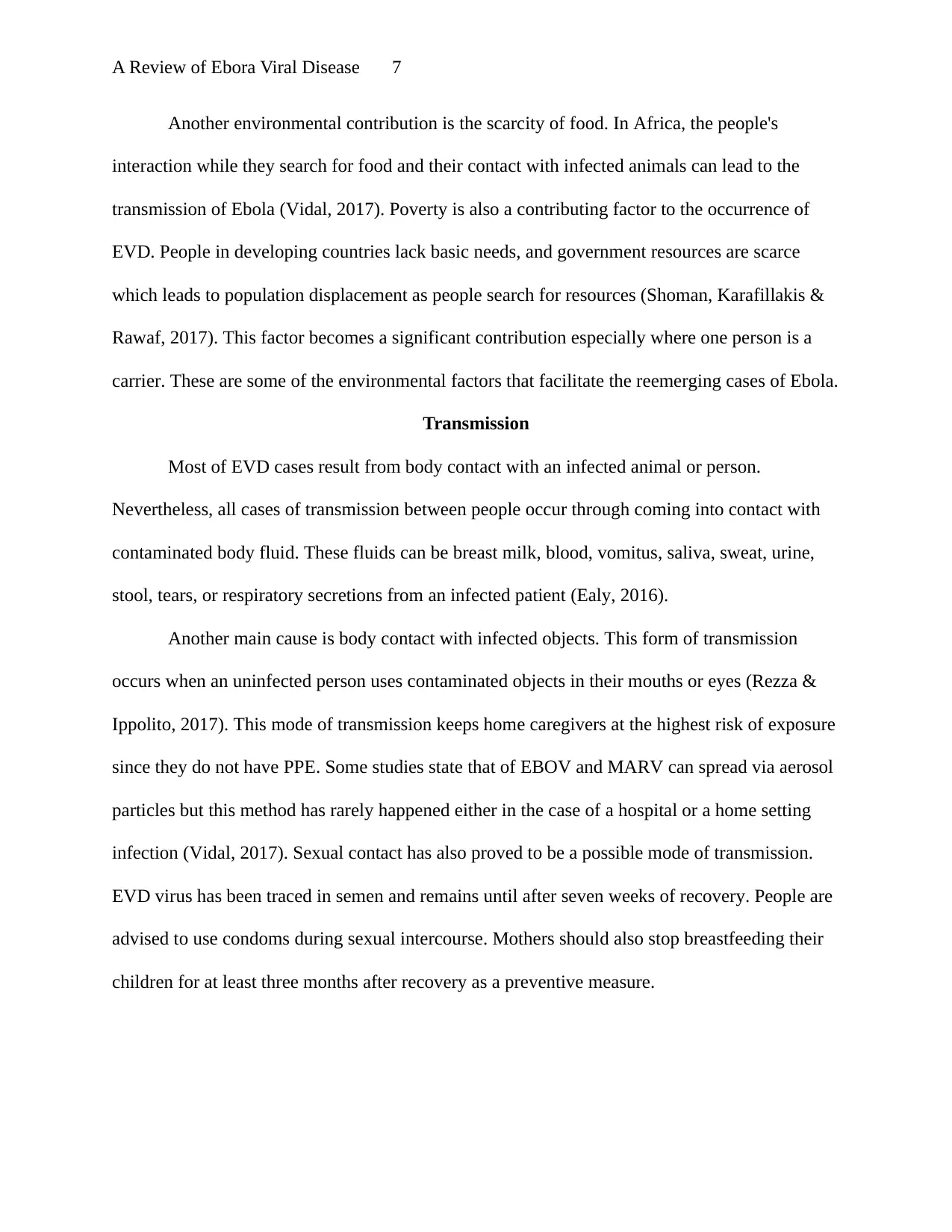
A Review of Ebora Viral Disease 7
Another environmental contribution is the scarcity of food. In Africa, the people's
interaction while they search for food and their contact with infected animals can lead to the
transmission of Ebola (Vidal, 2017). Poverty is also a contributing factor to the occurrence of
EVD. People in developing countries lack basic needs, and government resources are scarce
which leads to population displacement as people search for resources (Shoman, Karafillakis &
Rawaf, 2017). This factor becomes a significant contribution especially where one person is a
carrier. These are some of the environmental factors that facilitate the reemerging cases of Ebola.
Transmission
Most of EVD cases result from body contact with an infected animal or person.
Nevertheless, all cases of transmission between people occur through coming into contact with
contaminated body fluid. These fluids can be breast milk, blood, vomitus, saliva, sweat, urine,
stool, tears, or respiratory secretions from an infected patient (Ealy, 2016).
Another main cause is body contact with infected objects. This form of transmission
occurs when an uninfected person uses contaminated objects in their mouths or eyes (Rezza &
Ippolito, 2017). This mode of transmission keeps home caregivers at the highest risk of exposure
since they do not have PPE. Some studies state that of EBOV and MARV can spread via aerosol
particles but this method has rarely happened either in the case of a hospital or a home setting
infection (Vidal, 2017). Sexual contact has also proved to be a possible mode of transmission.
EVD virus has been traced in semen and remains until after seven weeks of recovery. People are
advised to use condoms during sexual intercourse. Mothers should also stop breastfeeding their
children for at least three months after recovery as a preventive measure.
Another environmental contribution is the scarcity of food. In Africa, the people's
interaction while they search for food and their contact with infected animals can lead to the
transmission of Ebola (Vidal, 2017). Poverty is also a contributing factor to the occurrence of
EVD. People in developing countries lack basic needs, and government resources are scarce
which leads to population displacement as people search for resources (Shoman, Karafillakis &
Rawaf, 2017). This factor becomes a significant contribution especially where one person is a
carrier. These are some of the environmental factors that facilitate the reemerging cases of Ebola.
Transmission
Most of EVD cases result from body contact with an infected animal or person.
Nevertheless, all cases of transmission between people occur through coming into contact with
contaminated body fluid. These fluids can be breast milk, blood, vomitus, saliva, sweat, urine,
stool, tears, or respiratory secretions from an infected patient (Ealy, 2016).
Another main cause is body contact with infected objects. This form of transmission
occurs when an uninfected person uses contaminated objects in their mouths or eyes (Rezza &
Ippolito, 2017). This mode of transmission keeps home caregivers at the highest risk of exposure
since they do not have PPE. Some studies state that of EBOV and MARV can spread via aerosol
particles but this method has rarely happened either in the case of a hospital or a home setting
infection (Vidal, 2017). Sexual contact has also proved to be a possible mode of transmission.
EVD virus has been traced in semen and remains until after seven weeks of recovery. People are
advised to use condoms during sexual intercourse. Mothers should also stop breastfeeding their
children for at least three months after recovery as a preventive measure.
Paraphrase This Document
Need a fresh take? Get an instant paraphrase of this document with our AI Paraphraser
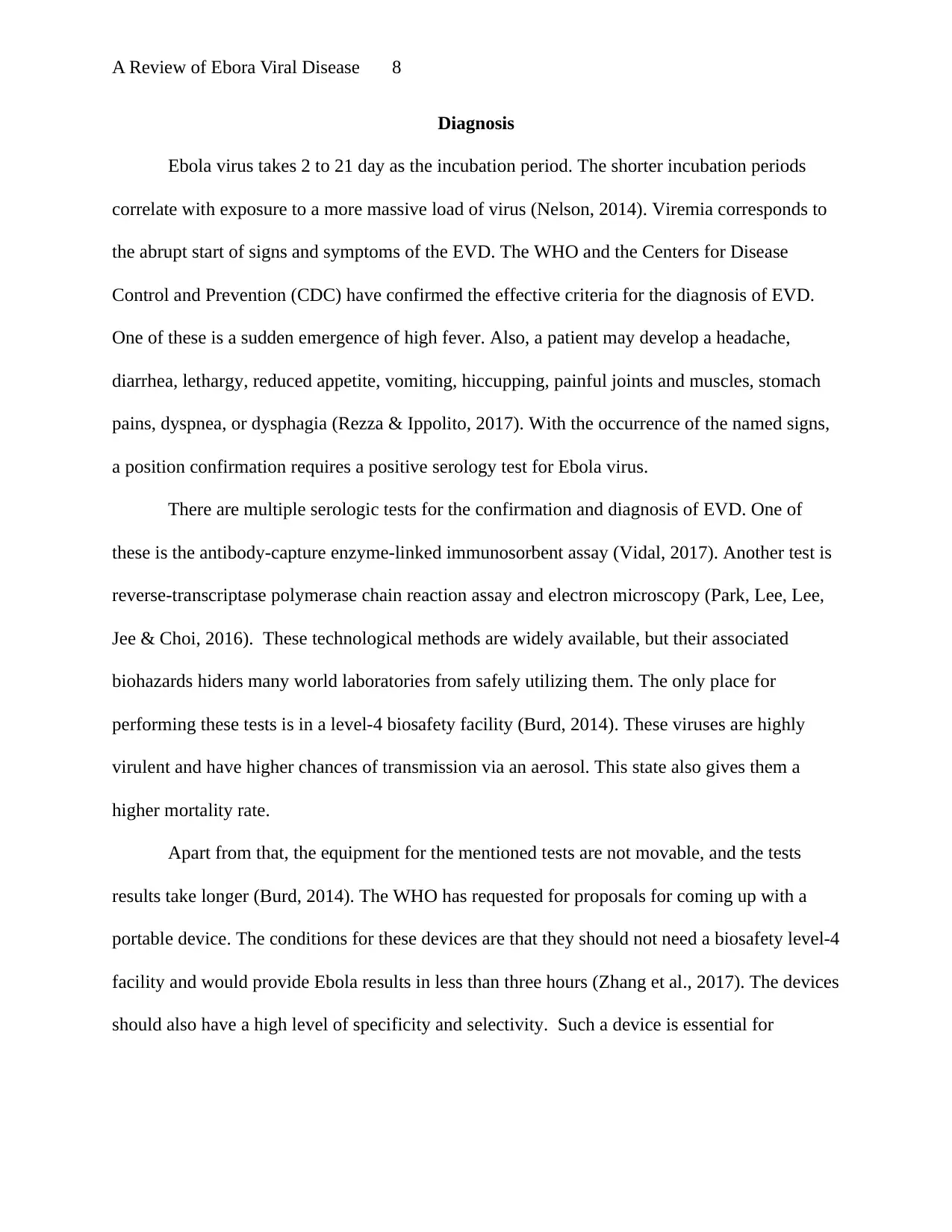
A Review of Ebora Viral Disease 8
Diagnosis
Ebola virus takes 2 to 21 day as the incubation period. The shorter incubation periods
correlate with exposure to a more massive load of virus (Nelson, 2014). Viremia corresponds to
the abrupt start of signs and symptoms of the EVD. The WHO and the Centers for Disease
Control and Prevention (CDC) have confirmed the effective criteria for the diagnosis of EVD.
One of these is a sudden emergence of high fever. Also, a patient may develop a headache,
diarrhea, lethargy, reduced appetite, vomiting, hiccupping, painful joints and muscles, stomach
pains, dyspnea, or dysphagia (Rezza & Ippolito, 2017). With the occurrence of the named signs,
a position confirmation requires a positive serology test for Ebola virus.
There are multiple serologic tests for the confirmation and diagnosis of EVD. One of
these is the antibody-capture enzyme-linked immunosorbent assay (Vidal, 2017). Another test is
reverse-transcriptase polymerase chain reaction assay and electron microscopy (Park, Lee, Lee,
Jee & Choi, 2016). These technological methods are widely available, but their associated
biohazards hiders many world laboratories from safely utilizing them. The only place for
performing these tests is in a level-4 biosafety facility (Burd, 2014). These viruses are highly
virulent and have higher chances of transmission via an aerosol. This state also gives them a
higher mortality rate.
Apart from that, the equipment for the mentioned tests are not movable, and the tests
results take longer (Burd, 2014). The WHO has requested for proposals for coming up with a
portable device. The conditions for these devices are that they should not need a biosafety level-4
facility and would provide Ebola results in less than three hours (Zhang et al., 2017). The devices
should also have a high level of specificity and selectivity. Such a device is essential for
Diagnosis
Ebola virus takes 2 to 21 day as the incubation period. The shorter incubation periods
correlate with exposure to a more massive load of virus (Nelson, 2014). Viremia corresponds to
the abrupt start of signs and symptoms of the EVD. The WHO and the Centers for Disease
Control and Prevention (CDC) have confirmed the effective criteria for the diagnosis of EVD.
One of these is a sudden emergence of high fever. Also, a patient may develop a headache,
diarrhea, lethargy, reduced appetite, vomiting, hiccupping, painful joints and muscles, stomach
pains, dyspnea, or dysphagia (Rezza & Ippolito, 2017). With the occurrence of the named signs,
a position confirmation requires a positive serology test for Ebola virus.
There are multiple serologic tests for the confirmation and diagnosis of EVD. One of
these is the antibody-capture enzyme-linked immunosorbent assay (Vidal, 2017). Another test is
reverse-transcriptase polymerase chain reaction assay and electron microscopy (Park, Lee, Lee,
Jee & Choi, 2016). These technological methods are widely available, but their associated
biohazards hiders many world laboratories from safely utilizing them. The only place for
performing these tests is in a level-4 biosafety facility (Burd, 2014). These viruses are highly
virulent and have higher chances of transmission via an aerosol. This state also gives them a
higher mortality rate.
Apart from that, the equipment for the mentioned tests are not movable, and the tests
results take longer (Burd, 2014). The WHO has requested for proposals for coming up with a
portable device. The conditions for these devices are that they should not need a biosafety level-4
facility and would provide Ebola results in less than three hours (Zhang et al., 2017). The devices
should also have a high level of specificity and selectivity. Such a device is essential for
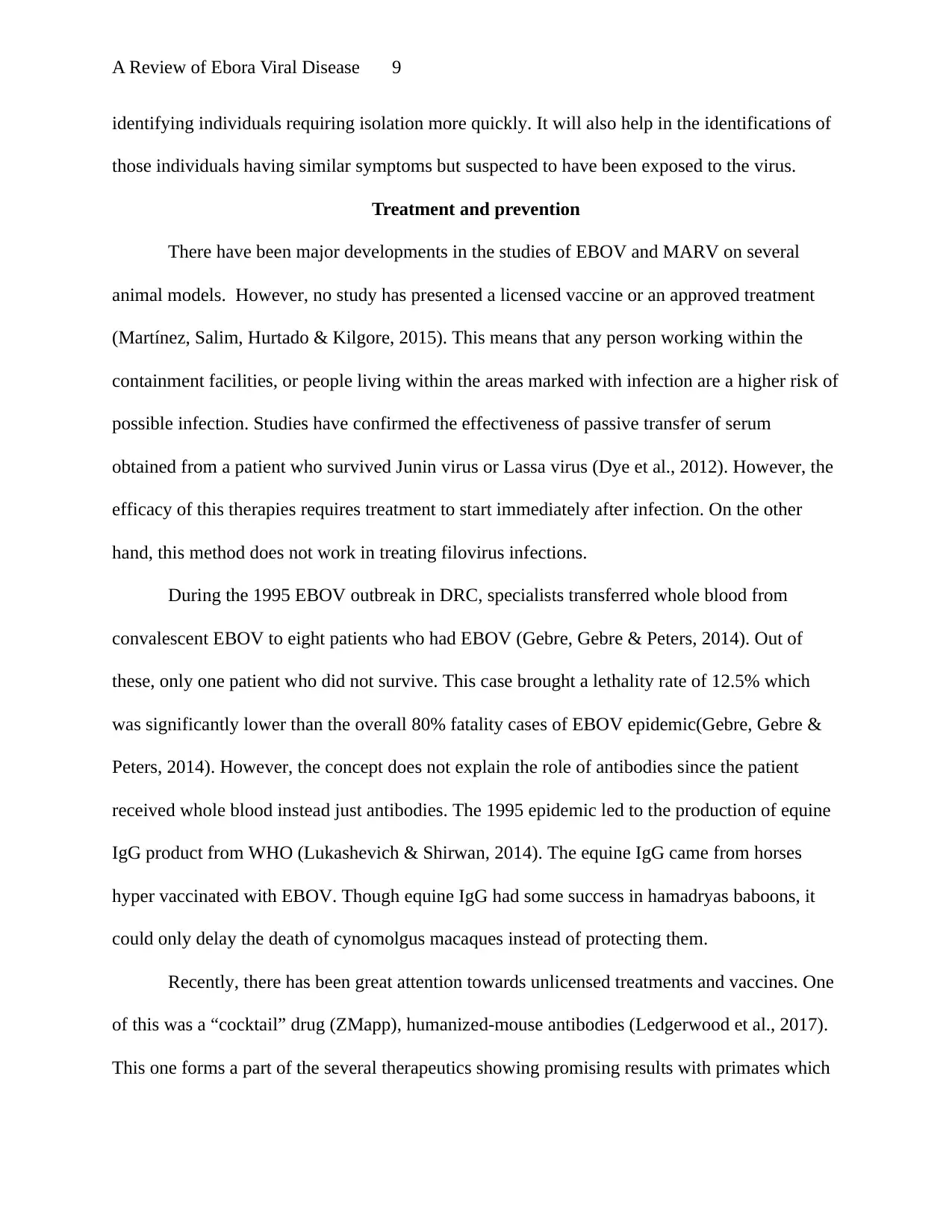
A Review of Ebora Viral Disease 9
identifying individuals requiring isolation more quickly. It will also help in the identifications of
those individuals having similar symptoms but suspected to have been exposed to the virus.
Treatment and prevention
There have been major developments in the studies of EBOV and MARV on several
animal models. However, no study has presented a licensed vaccine or an approved treatment
(Martínez, Salim, Hurtado & Kilgore, 2015). This means that any person working within the
containment facilities, or people living within the areas marked with infection are a higher risk of
possible infection. Studies have confirmed the effectiveness of passive transfer of serum
obtained from a patient who survived Junin virus or Lassa virus (Dye et al., 2012). However, the
efficacy of this therapies requires treatment to start immediately after infection. On the other
hand, this method does not work in treating filovirus infections.
During the 1995 EBOV outbreak in DRC, specialists transferred whole blood from
convalescent EBOV to eight patients who had EBOV (Gebre, Gebre & Peters, 2014). Out of
these, only one patient who did not survive. This case brought a lethality rate of 12.5% which
was significantly lower than the overall 80% fatality cases of EBOV epidemic(Gebre, Gebre &
Peters, 2014). However, the concept does not explain the role of antibodies since the patient
received whole blood instead just antibodies. The 1995 epidemic led to the production of equine
IgG product from WHO (Lukashevich & Shirwan, 2014). The equine IgG came from horses
hyper vaccinated with EBOV. Though equine IgG had some success in hamadryas baboons, it
could only delay the death of cynomolgus macaques instead of protecting them.
Recently, there has been great attention towards unlicensed treatments and vaccines. One
of this was a “cocktail” drug (ZMapp), humanized-mouse antibodies (Ledgerwood et al., 2017).
This one forms a part of the several therapeutics showing promising results with primates which
identifying individuals requiring isolation more quickly. It will also help in the identifications of
those individuals having similar symptoms but suspected to have been exposed to the virus.
Treatment and prevention
There have been major developments in the studies of EBOV and MARV on several
animal models. However, no study has presented a licensed vaccine or an approved treatment
(Martínez, Salim, Hurtado & Kilgore, 2015). This means that any person working within the
containment facilities, or people living within the areas marked with infection are a higher risk of
possible infection. Studies have confirmed the effectiveness of passive transfer of serum
obtained from a patient who survived Junin virus or Lassa virus (Dye et al., 2012). However, the
efficacy of this therapies requires treatment to start immediately after infection. On the other
hand, this method does not work in treating filovirus infections.
During the 1995 EBOV outbreak in DRC, specialists transferred whole blood from
convalescent EBOV to eight patients who had EBOV (Gebre, Gebre & Peters, 2014). Out of
these, only one patient who did not survive. This case brought a lethality rate of 12.5% which
was significantly lower than the overall 80% fatality cases of EBOV epidemic(Gebre, Gebre &
Peters, 2014). However, the concept does not explain the role of antibodies since the patient
received whole blood instead just antibodies. The 1995 epidemic led to the production of equine
IgG product from WHO (Lukashevich & Shirwan, 2014). The equine IgG came from horses
hyper vaccinated with EBOV. Though equine IgG had some success in hamadryas baboons, it
could only delay the death of cynomolgus macaques instead of protecting them.
Recently, there has been great attention towards unlicensed treatments and vaccines. One
of this was a “cocktail” drug (ZMapp), humanized-mouse antibodies (Ledgerwood et al., 2017).
This one forms a part of the several therapeutics showing promising results with primates which
⊘ This is a preview!⊘
Do you want full access?
Subscribe today to unlock all pages.

Trusted by 1+ million students worldwide
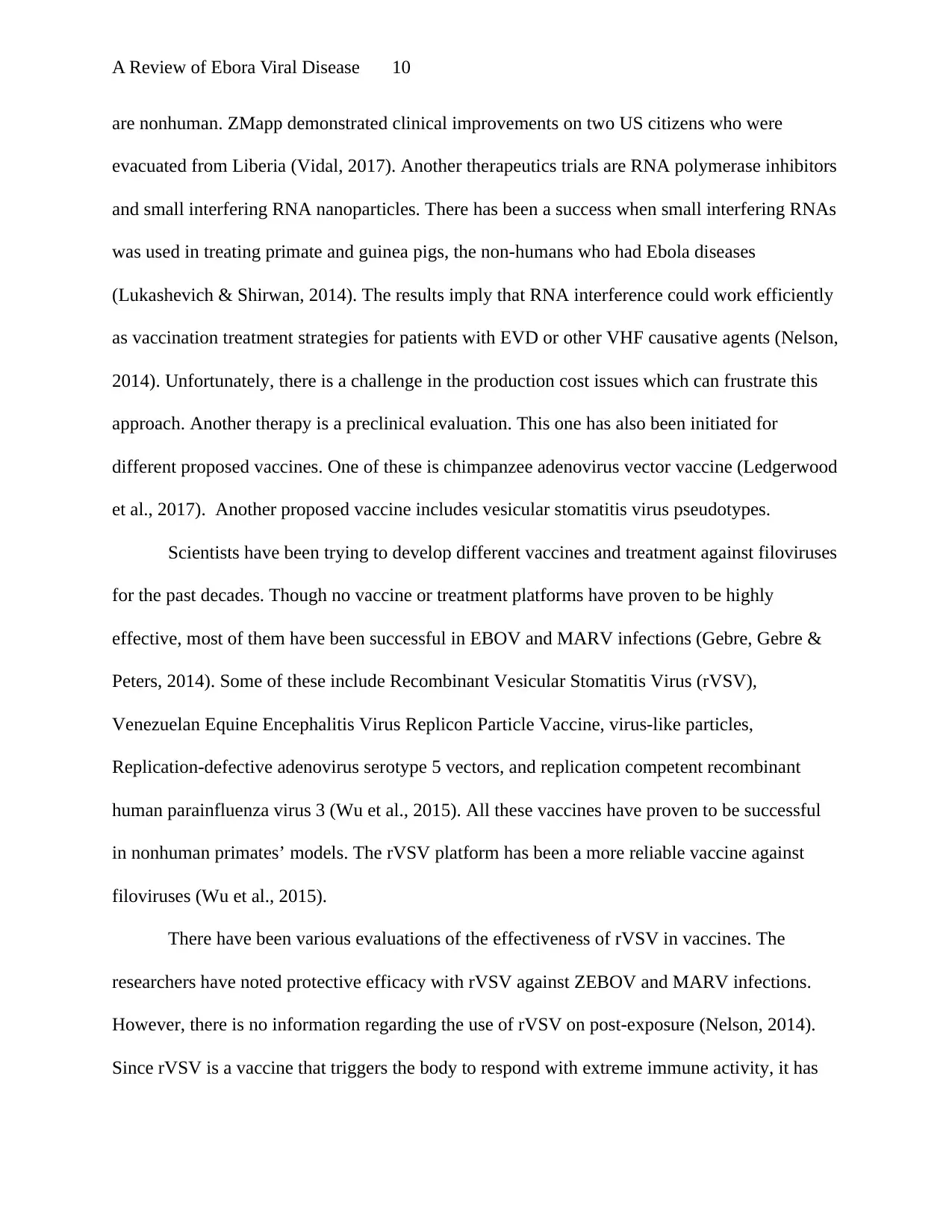
A Review of Ebora Viral Disease 10
are nonhuman. ZMapp demonstrated clinical improvements on two US citizens who were
evacuated from Liberia (Vidal, 2017). Another therapeutics trials are RNA polymerase inhibitors
and small interfering RNA nanoparticles. There has been a success when small interfering RNAs
was used in treating primate and guinea pigs, the non-humans who had Ebola diseases
(Lukashevich & Shirwan, 2014). The results imply that RNA interference could work efficiently
as vaccination treatment strategies for patients with EVD or other VHF causative agents (Nelson,
2014). Unfortunately, there is a challenge in the production cost issues which can frustrate this
approach. Another therapy is a preclinical evaluation. This one has also been initiated for
different proposed vaccines. One of these is chimpanzee adenovirus vector vaccine (Ledgerwood
et al., 2017). Another proposed vaccine includes vesicular stomatitis virus pseudotypes.
Scientists have been trying to develop different vaccines and treatment against filoviruses
for the past decades. Though no vaccine or treatment platforms have proven to be highly
effective, most of them have been successful in EBOV and MARV infections (Gebre, Gebre &
Peters, 2014). Some of these include Recombinant Vesicular Stomatitis Virus (rVSV),
Venezuelan Equine Encephalitis Virus Replicon Particle Vaccine, virus-like particles,
Replication-defective adenovirus serotype 5 vectors, and replication competent recombinant
human parainfluenza virus 3 (Wu et al., 2015). All these vaccines have proven to be successful
in nonhuman primates’ models. The rVSV platform has been a more reliable vaccine against
filoviruses (Wu et al., 2015).
There have been various evaluations of the effectiveness of rVSV in vaccines. The
researchers have noted protective efficacy with rVSV against ZEBOV and MARV infections.
However, there is no information regarding the use of rVSV on post-exposure (Nelson, 2014).
Since rVSV is a vaccine that triggers the body to respond with extreme immune activity, it has
are nonhuman. ZMapp demonstrated clinical improvements on two US citizens who were
evacuated from Liberia (Vidal, 2017). Another therapeutics trials are RNA polymerase inhibitors
and small interfering RNA nanoparticles. There has been a success when small interfering RNAs
was used in treating primate and guinea pigs, the non-humans who had Ebola diseases
(Lukashevich & Shirwan, 2014). The results imply that RNA interference could work efficiently
as vaccination treatment strategies for patients with EVD or other VHF causative agents (Nelson,
2014). Unfortunately, there is a challenge in the production cost issues which can frustrate this
approach. Another therapy is a preclinical evaluation. This one has also been initiated for
different proposed vaccines. One of these is chimpanzee adenovirus vector vaccine (Ledgerwood
et al., 2017). Another proposed vaccine includes vesicular stomatitis virus pseudotypes.
Scientists have been trying to develop different vaccines and treatment against filoviruses
for the past decades. Though no vaccine or treatment platforms have proven to be highly
effective, most of them have been successful in EBOV and MARV infections (Gebre, Gebre &
Peters, 2014). Some of these include Recombinant Vesicular Stomatitis Virus (rVSV),
Venezuelan Equine Encephalitis Virus Replicon Particle Vaccine, virus-like particles,
Replication-defective adenovirus serotype 5 vectors, and replication competent recombinant
human parainfluenza virus 3 (Wu et al., 2015). All these vaccines have proven to be successful
in nonhuman primates’ models. The rVSV platform has been a more reliable vaccine against
filoviruses (Wu et al., 2015).
There have been various evaluations of the effectiveness of rVSV in vaccines. The
researchers have noted protective efficacy with rVSV against ZEBOV and MARV infections.
However, there is no information regarding the use of rVSV on post-exposure (Nelson, 2014).
Since rVSV is a vaccine that triggers the body to respond with extreme immune activity, it has
Paraphrase This Document
Need a fresh take? Get an instant paraphrase of this document with our AI Paraphraser
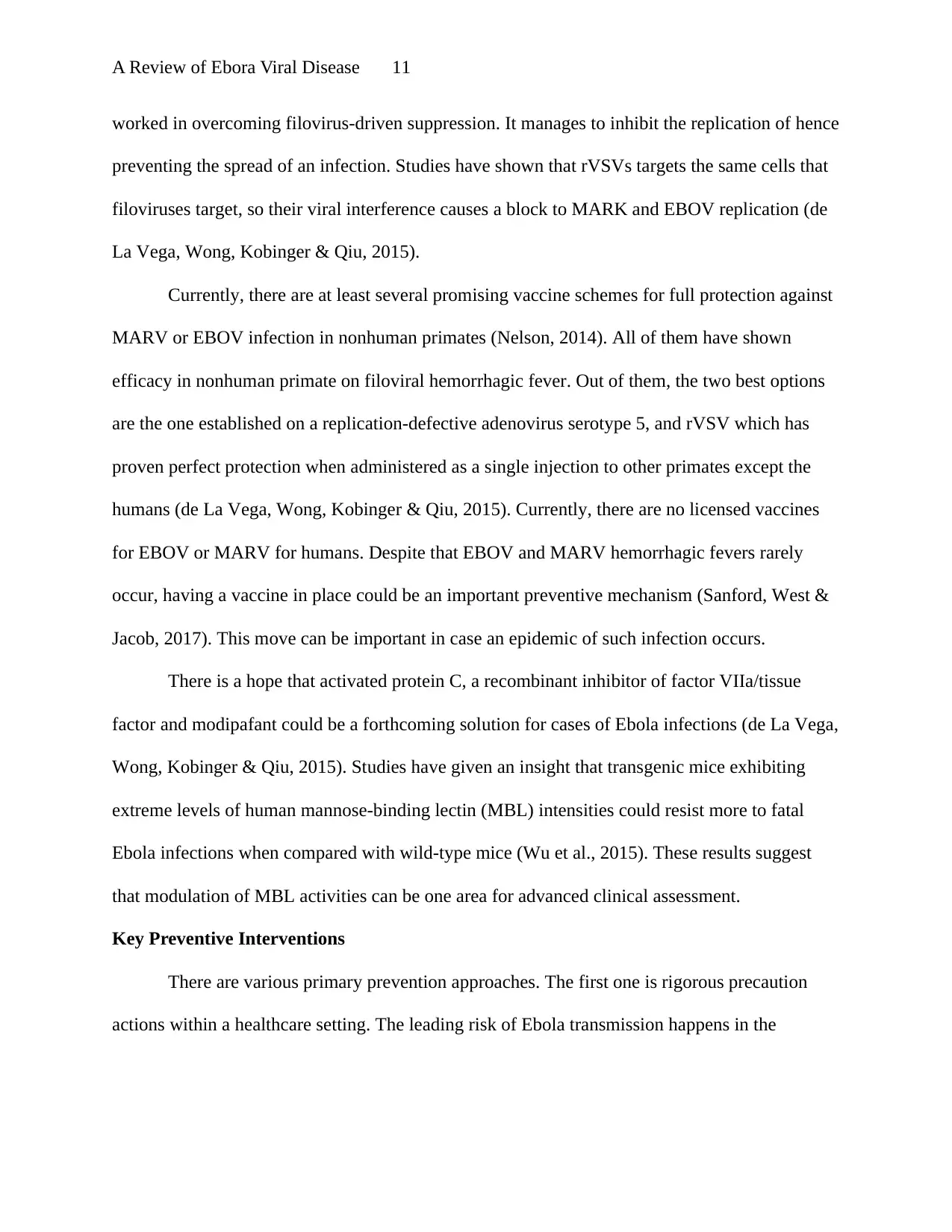
A Review of Ebora Viral Disease 11
worked in overcoming filovirus-driven suppression. It manages to inhibit the replication of hence
preventing the spread of an infection. Studies have shown that rVSVs targets the same cells that
filoviruses target, so their viral interference causes a block to MARK and EBOV replication (de
La Vega, Wong, Kobinger & Qiu, 2015).
Currently, there are at least several promising vaccine schemes for full protection against
MARV or EBOV infection in nonhuman primates (Nelson, 2014). All of them have shown
efficacy in nonhuman primate on filoviral hemorrhagic fever. Out of them, the two best options
are the one established on a replication-defective adenovirus serotype 5, and rVSV which has
proven perfect protection when administered as a single injection to other primates except the
humans (de La Vega, Wong, Kobinger & Qiu, 2015). Currently, there are no licensed vaccines
for EBOV or MARV for humans. Despite that EBOV and MARV hemorrhagic fevers rarely
occur, having a vaccine in place could be an important preventive mechanism (Sanford, West &
Jacob, 2017). This move can be important in case an epidemic of such infection occurs.
There is a hope that activated protein C, a recombinant inhibitor of factor VIIa/tissue
factor and modipafant could be a forthcoming solution for cases of Ebola infections (de La Vega,
Wong, Kobinger & Qiu, 2015). Studies have given an insight that transgenic mice exhibiting
extreme levels of human mannose-binding lectin (MBL) intensities could resist more to fatal
Ebola infections when compared with wild-type mice (Wu et al., 2015). These results suggest
that modulation of MBL activities can be one area for advanced clinical assessment.
Key Preventive Interventions
There are various primary prevention approaches. The first one is rigorous precaution
actions within a healthcare setting. The leading risk of Ebola transmission happens in the
worked in overcoming filovirus-driven suppression. It manages to inhibit the replication of hence
preventing the spread of an infection. Studies have shown that rVSVs targets the same cells that
filoviruses target, so their viral interference causes a block to MARK and EBOV replication (de
La Vega, Wong, Kobinger & Qiu, 2015).
Currently, there are at least several promising vaccine schemes for full protection against
MARV or EBOV infection in nonhuman primates (Nelson, 2014). All of them have shown
efficacy in nonhuman primate on filoviral hemorrhagic fever. Out of them, the two best options
are the one established on a replication-defective adenovirus serotype 5, and rVSV which has
proven perfect protection when administered as a single injection to other primates except the
humans (de La Vega, Wong, Kobinger & Qiu, 2015). Currently, there are no licensed vaccines
for EBOV or MARV for humans. Despite that EBOV and MARV hemorrhagic fevers rarely
occur, having a vaccine in place could be an important preventive mechanism (Sanford, West &
Jacob, 2017). This move can be important in case an epidemic of such infection occurs.
There is a hope that activated protein C, a recombinant inhibitor of factor VIIa/tissue
factor and modipafant could be a forthcoming solution for cases of Ebola infections (de La Vega,
Wong, Kobinger & Qiu, 2015). Studies have given an insight that transgenic mice exhibiting
extreme levels of human mannose-binding lectin (MBL) intensities could resist more to fatal
Ebola infections when compared with wild-type mice (Wu et al., 2015). These results suggest
that modulation of MBL activities can be one area for advanced clinical assessment.
Key Preventive Interventions
There are various primary prevention approaches. The first one is rigorous precaution
actions within a healthcare setting. The leading risk of Ebola transmission happens in the
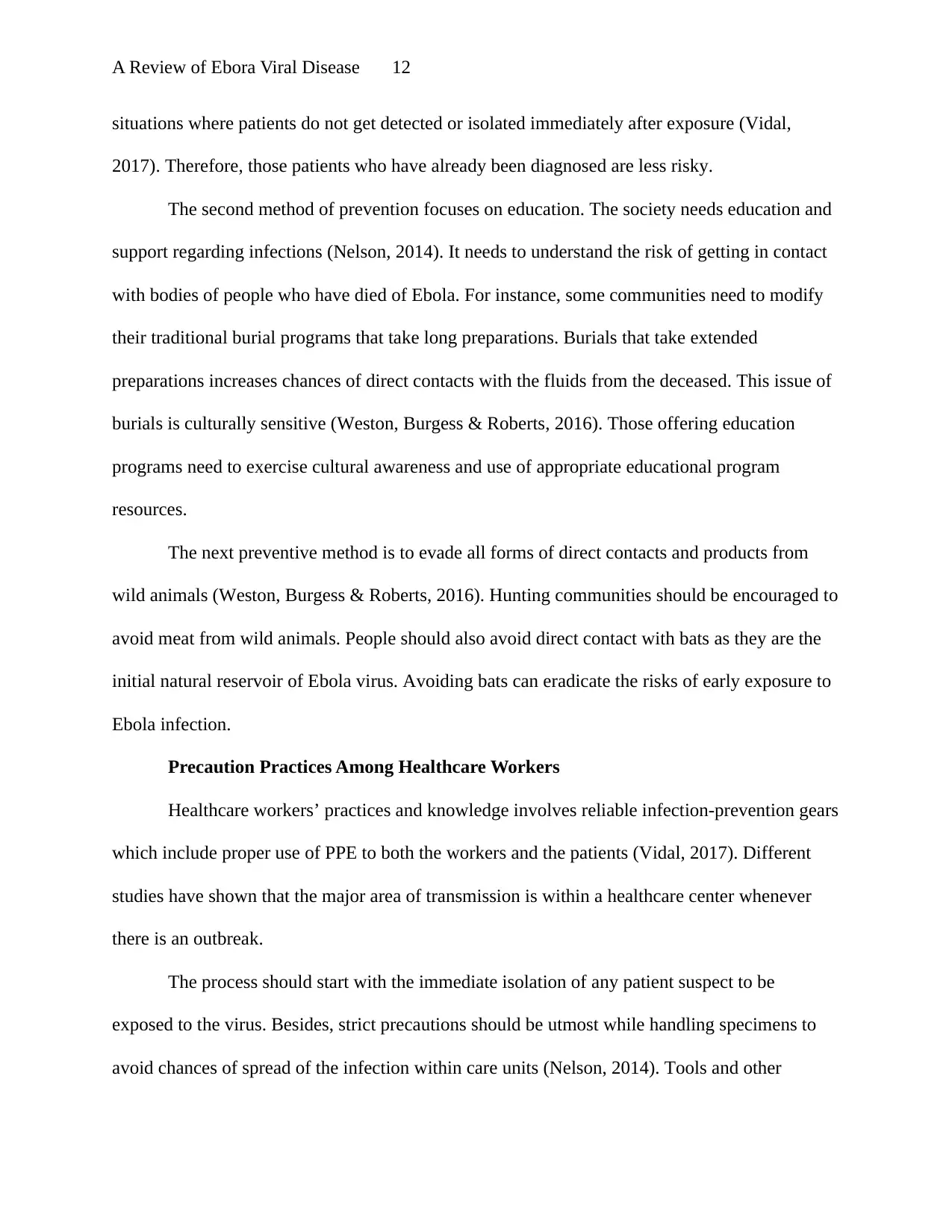
A Review of Ebora Viral Disease 12
situations where patients do not get detected or isolated immediately after exposure (Vidal,
2017). Therefore, those patients who have already been diagnosed are less risky.
The second method of prevention focuses on education. The society needs education and
support regarding infections (Nelson, 2014). It needs to understand the risk of getting in contact
with bodies of people who have died of Ebola. For instance, some communities need to modify
their traditional burial programs that take long preparations. Burials that take extended
preparations increases chances of direct contacts with the fluids from the deceased. This issue of
burials is culturally sensitive (Weston, Burgess & Roberts, 2016). Those offering education
programs need to exercise cultural awareness and use of appropriate educational program
resources.
The next preventive method is to evade all forms of direct contacts and products from
wild animals (Weston, Burgess & Roberts, 2016). Hunting communities should be encouraged to
avoid meat from wild animals. People should also avoid direct contact with bats as they are the
initial natural reservoir of Ebola virus. Avoiding bats can eradicate the risks of early exposure to
Ebola infection.
Precaution Practices Among Healthcare Workers
Healthcare workers’ practices and knowledge involves reliable infection-prevention gears
which include proper use of PPE to both the workers and the patients (Vidal, 2017). Different
studies have shown that the major area of transmission is within a healthcare center whenever
there is an outbreak.
The process should start with the immediate isolation of any patient suspect to be
exposed to the virus. Besides, strict precautions should be utmost while handling specimens to
avoid chances of spread of the infection within care units (Nelson, 2014). Tools and other
situations where patients do not get detected or isolated immediately after exposure (Vidal,
2017). Therefore, those patients who have already been diagnosed are less risky.
The second method of prevention focuses on education. The society needs education and
support regarding infections (Nelson, 2014). It needs to understand the risk of getting in contact
with bodies of people who have died of Ebola. For instance, some communities need to modify
their traditional burial programs that take long preparations. Burials that take extended
preparations increases chances of direct contacts with the fluids from the deceased. This issue of
burials is culturally sensitive (Weston, Burgess & Roberts, 2016). Those offering education
programs need to exercise cultural awareness and use of appropriate educational program
resources.
The next preventive method is to evade all forms of direct contacts and products from
wild animals (Weston, Burgess & Roberts, 2016). Hunting communities should be encouraged to
avoid meat from wild animals. People should also avoid direct contact with bats as they are the
initial natural reservoir of Ebola virus. Avoiding bats can eradicate the risks of early exposure to
Ebola infection.
Precaution Practices Among Healthcare Workers
Healthcare workers’ practices and knowledge involves reliable infection-prevention gears
which include proper use of PPE to both the workers and the patients (Vidal, 2017). Different
studies have shown that the major area of transmission is within a healthcare center whenever
there is an outbreak.
The process should start with the immediate isolation of any patient suspect to be
exposed to the virus. Besides, strict precautions should be utmost while handling specimens to
avoid chances of spread of the infection within care units (Nelson, 2014). Tools and other
⊘ This is a preview!⊘
Do you want full access?
Subscribe today to unlock all pages.

Trusted by 1+ million students worldwide
1 out of 17
Related Documents
Your All-in-One AI-Powered Toolkit for Academic Success.
+13062052269
info@desklib.com
Available 24*7 on WhatsApp / Email
![[object Object]](/_next/static/media/star-bottom.7253800d.svg)
Unlock your academic potential
Copyright © 2020–2025 A2Z Services. All Rights Reserved. Developed and managed by ZUCOL.




